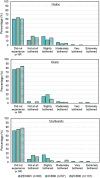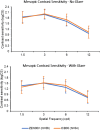Quality of vision clinical outcomes for a new fully-refractive extended depth of focus Intraocular Lens
- PMID: 38580741
- PMCID: PMC11080637
- DOI: 10.1038/s41433-024-03039-8
Quality of vision clinical outcomes for a new fully-refractive extended depth of focus Intraocular Lens
Erratum in
-
Correction: Quality of vision clinical outcomes for a new fully-refractive extended depth of focus intraocular lens.Eye (Lond). 2025 Jan;39(1):202. doi: 10.1038/s41433-024-03421-6. Eye (Lond). 2025. PMID: 39501006 Free PMC article. No abstract available.
Abstract
Background/objective: To evaluate the visual performance of a purely refractive extended depth of focus (EDF) intraocular lens (IOL).
Subjects/methods: A prospective, multi-center, randomized, subject/evaluator-masked study. Subjects were bilaterally implanted with the EDF test (Model ZEN00V, TECNIS PureSee™ IOL, N = 60) or an enhanced monofocal control (Model ICB00, TECNIS Eyhance™ IOL, N = 57) IOL. Monocular corrected distance (CDVA), intermediate (DCIVA), near acuities (DCNVA) and patient reported visual symptoms were evaluated at the 6-month visit. Monocular mesopic contrast sensitivity (CS) and depth of focus (DOF) testing were assessed at 3 months.
Results: CDVA (Mean ± SD) was -0.06 ± 0.08 for test and -0.05 ± 0.08 logMAR for control groups. DCIVA was 0.13 ± 0.08 for test and 0.18 ± 0.14 logMAR for control groups (p = 0.0127). DCNVA was 0.37 ± 0.10 for test and 0.43 ± 0.16 logMAR for control groups (p = 0.0137). Test lens was statistically superior for intermediate and near. Overall, 91.7% (halos), 95.0% (starbursts) and 95.0% (glare) of test lens patients reported that they did not experience, were not bothered, or were slightly bothered by specific visual symptoms, compared to 98.2%, 100% and 96.5% in the control group. The DOF range over which monocular visual acuity was 0.20 logMAR or better was -1.6 D for the test lens. Mesopic CS was comparable between both groups, falling within 0.11 log units for all measured cycles per degree with and without glare.
Conclusion: The EDF IOL demonstrated extended range of vision and statistically superior intermediate and near performance compared to the monofocal IOL. Distance visual acuity, contrast sensitivity and dysphotopsia profile were similar to the monofocal IOL.
© 2024. The Author(s).
Conflict of interest statement
DC: None. DB: Consultant to, and performs research supported by, Johnson & Johnson Surgical Vision, Inc. CB: Consultant to, and performs research supported by, Johnson & Johnson Surgical Vision, Inc. and Alcon. TVR: Received investigator grants from J&J Vision and Alcon, and participated on advisory boards for Alcon, J&J Vision, Glaukos and Hoya. BC: Received consulting fees from Glaukos, Allergan, and J&J Vision. DG: Received consulting fees from Alcon and participated on paid advisory boards and as a speaker for Alcon. PV: Received clinical trial funding from J&J Vision, paid medical advisor for Teleon, Germany, participated on paid advisory boards for J&J Vision, and received speaker fees from STAAR Surgical. LT, EP, AA, and SV: Employees of Johnson & Johnson Surgical Vision, Inc.
Figures



Similar articles
-
Tolerance to refractive error with a new extended depth of focus intraocular lens.Eye (Lond). 2024 May;38(Suppl 1):15-20. doi: 10.1038/s41433-024-03040-1. Epub 2024 Apr 5. Eye (Lond). 2024. PMID: 38580742 Free PMC article. Clinical Trial.
-
Visual and Patient-Reported Outcomes of a Diffractive Trifocal Intraocular Lens Compared with Those of a Monofocal Intraocular Lens.Ophthalmology. 2021 Feb;128(2):197-207. doi: 10.1016/j.ophtha.2020.07.015. Epub 2020 Sep 28. Ophthalmology. 2021. PMID: 33004211 Clinical Trial.
-
Comparing an Advanced Monofocal With a Non-diffractive Extended Depth of Focus Intraocular Lens Using a Mini-Monovision Approach.Am J Ophthalmol. 2025 Mar;271:86-95. doi: 10.1016/j.ajo.2024.10.014. Epub 2024 Oct 28. Am J Ophthalmol. 2025. PMID: 39490721 Clinical Trial.
-
A comparative study of the visual outcomes between a new trifocal and an extended depth of focus intraocular lens.Eur J Ophthalmol. 2018 Mar;28(2):182-187. doi: 10.5301/ejo.5001029. Epub 2017 Aug 9. Eur J Ophthalmol. 2018. PMID: 28885672
-
Comparison of Visual Outcomes and Patient Satisfaction After Bilateral Implantation of an EDOF IOL and a Mix-and-Match Approach.J Refract Surg. 2019 Jul 1;35(7):408-416. doi: 10.3928/1081597X-20190417-02. J Refract Surg. 2019. PMID: 31298720 Clinical Trial.
Cited by
-
Optical Bench Evaluation of the Latest Refractive Enhanced Depth of Focus Intraocular Lens.Clin Ophthalmol. 2024 Jul 3;18:1921-1932. doi: 10.2147/OPTH.S469849. eCollection 2024. Clin Ophthalmol. 2024. PMID: 38978835 Free PMC article.
-
Tolerance to refractive error with a new extended depth of focus intraocular lens.Eye (Lond). 2024 May;38(Suppl 1):15-20. doi: 10.1038/s41433-024-03040-1. Epub 2024 Apr 5. Eye (Lond). 2024. PMID: 38580742 Free PMC article. Clinical Trial.
-
Comment on: "Quality of vision clinical outcomes for a new fully-refractive extended depth of focus intraocular lens".Eye (Lond). 2024 Oct;38(15):3031. doi: 10.1038/s41433-024-03210-1. Epub 2024 Jul 3. Eye (Lond). 2024. PMID: 38961145 No abstract available.
-
Evaluation of Clareon Vivity and PureSee intraocular lenses: optical quality, depth of focus and misalignment effects.Sci Rep. 2025 Jul 24;15(1):26943. doi: 10.1038/s41598-025-07970-y. Sci Rep. 2025. PMID: 40707598 Free PMC article.
-
Outcomes of mini-monovision with monofocal, enhanced monofocal and extended depth-of-focus intraocular lenses.Front Med (Lausanne). 2025 Feb 21;12:1522383. doi: 10.3389/fmed.2025.1522383. eCollection 2025. Front Med (Lausanne). 2025. PMID: 40061383 Free PMC article. Review.
References
-
- Synek S. The latest generation of intraocular lenses, the problem of the eye refraction after cataract surgery. Coll Antropol. 2013;37:217–21. - PubMed
-
- Khandelwal SS, Jun JJ, Mak S, Booth MS, Shekelle PG. Effectiveness of multifocal and monofocal intraocular lenses for cataract surgery and lens replacement: a systematic review and meta-analysis. Graefes Arch Clin Exp Ophthalmol. 2019;257:863–75. - PubMed
-
- Auffarth GU, Gerl M, Tsai L, Janakiraman DP, Jackson B, Alarcon A, et al. Clinical evaluation of a new monofocal IOL with enhanced intermediate function in patients with cataract. J Cataract Refract Surg. 2021;47:184–91. - PubMed
-
- Schallhorn JM. Multifocal and extended depth of focus intraocular lenses: a comparison of data from the United States food and drug administration premarket approval trials. J Refract Surg. 2021;37:98–104. - PubMed
-
- Barnett BP. FOCUSED (Femtosecond Optimized Continuous Uncorrected Sight with EDOF and Diffractive Multifocal IOLs) - A Review. Curr Opin Ophthalmol. 2021;32:3–12. - PubMed
Publication types
MeSH terms
LinkOut - more resources
Full Text Sources

